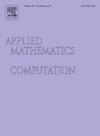流体-多孔系统的Stokes-Brinkman-Darcy模型:推导、分析和验证
IF 3.4
2区 数学
Q1 MATHEMATICS, APPLIED
引用次数: 0
摘要
由于在生物、环境和工业领域的广泛应用,接触多孔层的平面流体区域之间的流动相互作用引起了建模和分析方面的广泛关注。在最广泛使用的耦合模型中,流体流动由自由流域的Stokes方程和多孔介质中的Darcy定律来描述,并辅以适当的界面条件。然而,除了少数例外,传统的耦合概念仅限于平行于流-孔界面的一维流动。在这项工作中,我们通过考虑过渡区,使用另一种方法来模拟平面流体域与多孔介质之间的相互作用,并提出了全维和混合维Stokes-Brinkman-Darcy模型。在第一种情况下,在过渡区考虑等维Brinkman方程,并在过渡区顶部和底部设置适当的界面条件。在后一种情况下,我们通过在法向上平均布林克曼方程并使用所提出的传输条件来执行维度模型缩减。证明了这两个耦合问题的适定性,并进行了一些数值模拟来验证这些概念。本文章由计算机程序翻译,如有差异,请以英文原文为准。
Stokes–Brinkman–Darcy models for fluid–porous systems: derivation, analysis and validation
Flow interaction between a plain-fluid region in contact with a porous layer attracted significant attention from modelling and analysis sides due to numerous applications in biology, environment and industry. In the most widely used coupled model, fluid flow is described by the Stokes equations in the free-flow domain and Darcy’s law in the porous medium, and complemented by the appropriate interface conditions. However, traditional coupling concepts are restricted, with a few exceptions, to one-dimensional flows parallel to the fluid–porous interface.
In this work, we use an alternative approach to model interaction between the plain-fluid domain and porous medium by considering a transition zone, and propose the full- and hybrid-dimensional Stokes–Brinkman–Darcy models. In the first case, the equi-dimensional Brinkman equations are considered in the transition region, and the appropriate interface conditions are set on the top and bottom of the transition zone. In the latter case, we perform a dimensional model reduction by averaging the Brinkman equations in the normal direction and using the proposed transmission conditions. The well-posedness of both coupled problems is proved, and some numerical simulations are carried out in order to validate the concepts.
求助全文
通过发布文献求助,成功后即可免费获取论文全文。
去求助
来源期刊
CiteScore
7.90
自引率
10.00%
发文量
755
审稿时长
36 days
期刊介绍:
Applied Mathematics and Computation addresses work at the interface between applied mathematics, numerical computation, and applications of systems – oriented ideas to the physical, biological, social, and behavioral sciences, and emphasizes papers of a computational nature focusing on new algorithms, their analysis and numerical results.
In addition to presenting research papers, Applied Mathematics and Computation publishes review articles and single–topics issues.

 求助内容:
求助内容: 应助结果提醒方式:
应助结果提醒方式:


